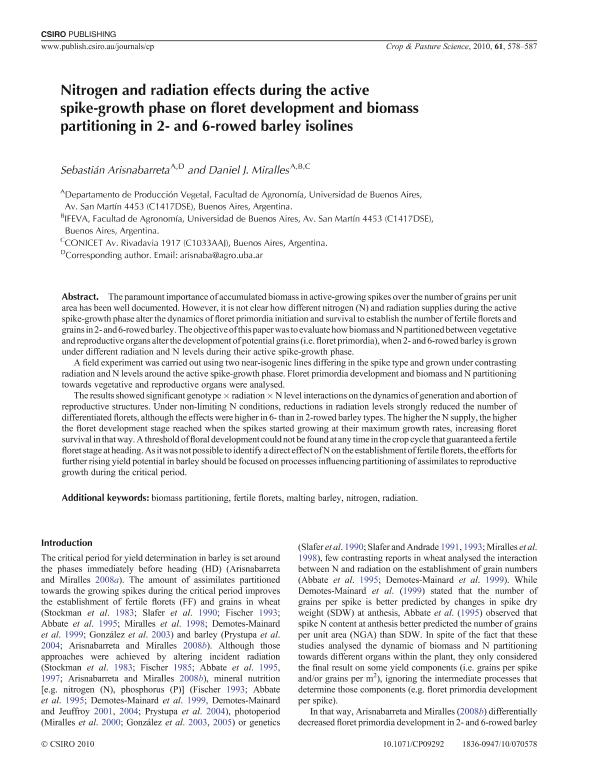Mostrar el registro sencillo del ítem
dc.contributor.author
Arisnabarreta Dupuy, Sebastián

dc.contributor.author
Miralles, Daniel Julio

dc.date.available
2019-04-24T19:14:20Z
dc.date.issued
2010-10
dc.identifier.citation
Arisnabarreta Dupuy, Sebastián; Miralles, Daniel Julio; Nitrogen and radiation effects during the active spike-growth phase on floret development and biomass partitioning in 2- and 6-rowed barley isolines; Csiro Publishing; Crop and Pasture Science; 61; 7; 10-2010; 578-587
dc.identifier.issn
1836-0947
dc.identifier.uri
http://hdl.handle.net/11336/74950
dc.description.abstract
The paramount importance of accumulated biomass in active-growing spikes over the number of grains per unit area has been well documented. However, it is not clear how different nitrogen (N) and radiation supplies during the active spike-growth phase alter the dynamics of floret primordia initiation and survival to establish the number of fertile florets and grains in 2- and 6-rowed barley. The objective of this paper was to evaluate how biomass and N partitioned between vegetative and reproductive organs alter the development of potential grains (i.e. floret primordia), when 2- and 6-rowed barley is grown under different radiation and N levels during their active spike-growth phase. A field experiment was carried out using two near-isogenic lines differing in the spike type and grown under contrasting radiation and N levels around the active spike-growth phase. Floret primordia development and biomass and N partitioning towards vegetative and reproductive organs were analysed. The results showed significant genotype ×radiation ×N level interactions on the dynamics of generation and abortion of reproductive structures. Under non-limiting N conditions, reductions in radiation levels strongly reduced the number of differentiated florets, although the effects were higher in 6- than in 2-rowed barley types. The higher the N supply, the higher the floret development stage reached when the spikes started growing at their maximum growth rates, increasing floret survival in that way. A threshold of floral development could not be found at any time in the crop cycle that guaranteed a fertile floret stage at heading. As it was not possible to identify a direct effect of N on the establishment of fertile florets, the efforts for further rising yield potential in barley should be focused on processes influencing partitioning of assimilates to reproductive growth during the critical period.
dc.format
application/pdf
dc.language.iso
eng
dc.publisher
Csiro Publishing

dc.rights
info:eu-repo/semantics/openAccess
dc.rights.uri
https://creativecommons.org/licenses/by-nc-sa/2.5/ar/
dc.subject
Biomass Partitioning
dc.subject
Fertile Florets
dc.subject
Malting Barley
dc.subject
Nitrogen
dc.subject
Radiation
dc.subject.classification
Agricultura

dc.subject.classification
Agricultura, Silvicultura y Pesca

dc.subject.classification
CIENCIAS AGRÍCOLAS

dc.title
Nitrogen and radiation effects during the active spike-growth phase on floret development and biomass partitioning in 2- and 6-rowed barley isolines
dc.type
info:eu-repo/semantics/article
dc.type
info:ar-repo/semantics/artículo
dc.type
info:eu-repo/semantics/publishedVersion
dc.date.updated
2019-03-08T20:19:32Z
dc.journal.volume
61
dc.journal.number
7
dc.journal.pagination
578-587
dc.journal.pais
Australia

dc.journal.ciudad
Canberra
dc.description.fil
Fil: Arisnabarreta Dupuy, Sebastián. Universidad de Buenos Aires. Facultad de Agronomía. Departamento de Producción Vegetal; Argentina
dc.description.fil
Fil: Miralles, Daniel Julio. Universidad de Buenos Aires. Facultad de Agronomía. Departamento de Producción Vegetal; Argentina. Consejo Nacional de Investigaciones Científicas y Técnicas; Argentina
dc.journal.title
Crop and Pasture Science
dc.relation.alternativeid
info:eu-repo/semantics/altIdentifier/doi/http://dx.doi.org/10.1071/CP09292
dc.relation.alternativeid
info:eu-repo/semantics/altIdentifier/url/http://www.publish.csiro.au/cp/CP09292
Archivos asociados
